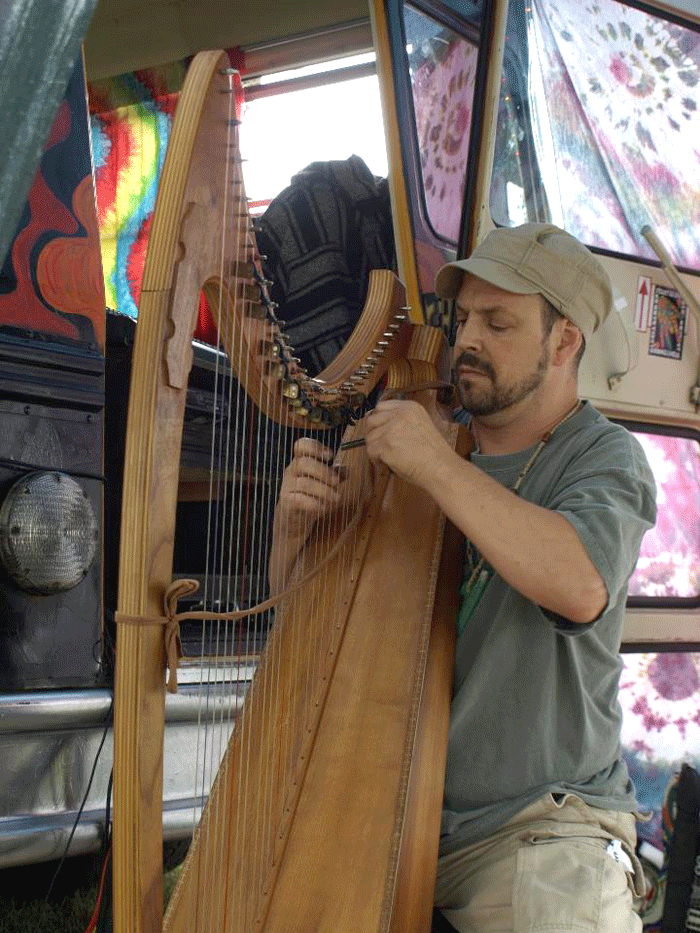If you’ve ever seen the ” C OOL Bus” with the gnarly paint job on the streets of Fort Wayne and wondered about the story behind it, wonder no more. It’s a former school bus Dan Dickerson uses as a mobile operation center for his Harp Condition phenomenon (he painted over the “s” and the “h” in “school” to transform it into the C OOL BUS).
As its title would suggest, the central feature of the Harp Condition is Dickerson’s harp – only this is no ordinary harp. It is a homemade unit originally built for him by his mother that he’s customized and electrified himself. And when he plays out of the tent that opens up from the rear of the bus, the music isn’t of the rarefied, classical variety one would normally associate with the instrument. Dickerson typically plays in a contemporary rock/jam band style; when he plays the harp, the sounds it produces can range from airy atmospherics to slide-driven blues licks played through a guitar effects processor.
As for his approach to playing, Dickerson describes himself as a “looper,” someone who uses an electronic drum machine to build up repeating rhythm tracks to play along to. While he typically has his harp, drum machine and guitar for himself to play, he frequently invites guest musicians to play along with him, and he keeps several other instruments on hand (tambourines, maracas) so audience members can play along.
While as Harp Condition Dickerson occasionally plays traditional clubs, he prefers to play festivals where he can use the bus to play to an impromptu crowd.
“We have a power inverter hooked to our battery, so I can run my stuff out of the bus no matter where I’m at. I can play without an outlet because I’m using the battery for power,” says Dickerson. “That means if we go to a festival, I”m playing whether they like it or not. I love it.”
The fun and slightly irreverent approach to harp play is in keeping with his original inspiration for playing the harp: classic film comedian Harpo Marx. As Marx Brothers fans know, Harpo was a capable harpist who never spoke and would use his harp, other props and body language for his comedy schtick. Dickerson is also inspired by multi-instrumentalist jam musician Keller Williams whose style is also far from dour.
“Harpo was obviously way skilled at the harp, but he was kinda goofy, you know? And that’s what I like about Keller Williams so much. He’s just really talented, amazing,” Dickerson says. “However, he doesn’t focus on me, me, me, look what I can do. He’s just goofy. He’s silly. He’s got a great voice, he’s got an awesome range, but he doesn’t show it off all the time, and that’s what I like about Harpo as well.”
It was a scene from the Marx Brothers film A Day at the Races in which Harpo destroys a piano, pulls out the center and starts playing it like a harp, that initially prompted Dickerson to try his hand at playing the instrument. After witnessing that scene, he asked his mother, who worked with antiques, if he could acquire an old piano to use its center as a harp. Rather than taking that approach, she looked into acquiring an actual harp, which turned out to be cost-prohibitive. After some more searching she eventually found a company that sold construction plans and kits for musical instruments and eventually built Dickerson’s harp herself.
While the homemade harp has proven sturdy over the years, it also presents challenges when compared to a traditional harp. For example, while a harpist playing a standard harp will use pedals on his or her instrument to play sharp and flat notes, Dickerson has levers which he must use to manually change the strings to sharp or flat.
“Traditional harps have foot pedals, and you can just hit the pedal. I can’t do that, I have to reach over with my right hand or push over with my left hand, make that sharp or flat happen, then undo it on the way back if it needs to go away,” he says. “I have to find a way to hit that lever manually which makes it kind of tough. But that’s the fun of it … I don’t really know how to play the harp, I just know how to play my harp.”
This year Dickerson plans to record his live performances locally at upcoming festivals (which include Meet the Music, Soulfest, Darkstar Jubilee, and the All Good Festival) and put the footage into a promotional video. The project will be called Dancing in Our Streets.
“We’re gonna do Dancing in Our Streets, not just at festivals, but local Fort Wayne stuff, and we’re gonna get the iPod and other recording equipment out. It’ll be kind of fun,” he says. “We’re gonna get people dancing around and having a good time – that’s what the bus usually brings – and document the whole thing and record everything that we can and ultimately culminate into Dancing in Our Streets.
“Everybody’s welcome,” he adds. “There’s a lot of friends of ours who already just record it on their phone, and it’s on the internet. Before I’m even done with the song it’s up.”
And with Dickerson’s looping approach to play, he could almost just as easily participate in the filming of the crowd as playing an event. While he does focus on the music, if things are going well the loops allow him to exit his instrument circle and interact with the crowd.
“If we’re having a good time I’m able to get a loop going, step outside, have a good time with people, high five, say hello, do a shot, whatever,” he says.

